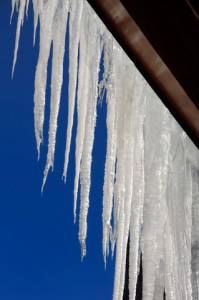
Remember in your early years of science class when you learned that water expands when it turns to ice?
It’s still true!
On flat or low sloped roofs, especially, ice will open existing holes or voids so that they can really leak into your building. If there is the slightest gap between your layers of roof membrane, water can enter these areas. As that water freezes, it expands, therefore opening the small gap into a larger gap. Many good roofs leak after an ice event. Don’t worry, it can be repaired.
Ice and cold weather can also cause your flat roof products to contract. This may cause the two parts to separate which will usually result in a leak. If the roof was properly installed this should not happen, but remember the roof was put on by humans and human error will always be a factor.
On steep sloped roof, ice can cause damming. This is where the ice builds up on the roof so that the melting water is caught, like a dam. Since steep sloped roofs are not water proofers the water will enter in between the shingles and cause a leak. This typically occurs at the bottom of a valley where leaves and debris have built up or at the eves where it is colder and ice can form quickly.
On standing seam metal roofs the ice can build up over the seam and find an entry point at the seam. This is not a common occurance but it can happen. Since metal expands and contracts a great deal the seams of the roof could be separated more than usual under the ice. The biggest hazard with ice on standing seam meal roofs in the South is that we do not typically design them for ice melting conditions. When a big sheet of ice finally melts and starts to slide off the roof it comes off in long spears. Some can be quite heavy and sharp. The ice will be moving swiftly and can cause major damage when it hits something or somebody.
Enjoy the little bit of ice and snow we get in our typically warm Winters. We don’t get that experience often. But remember, we build for the heat here in Texas and cold weather can cause some unexpected problems.
